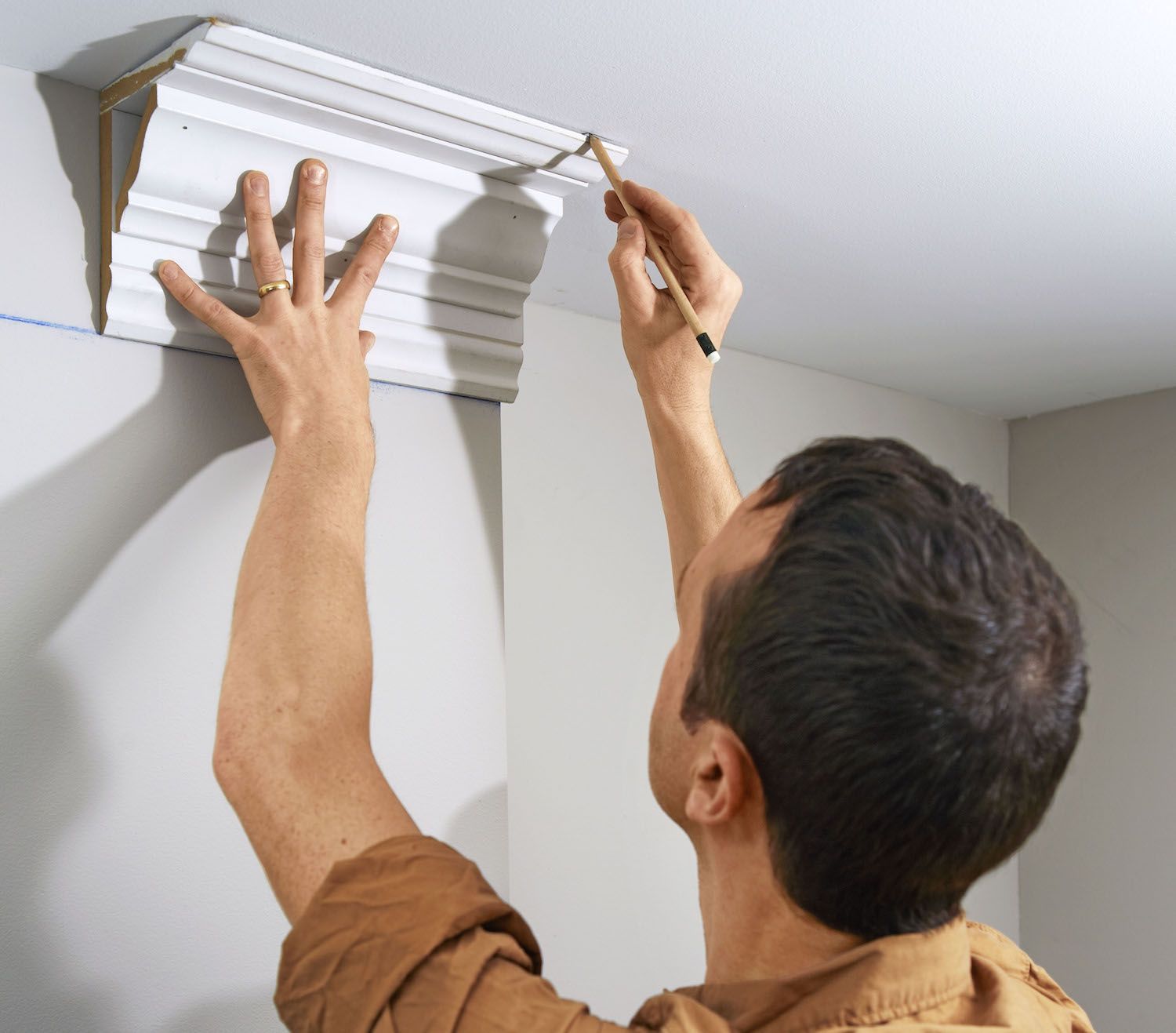Ceiling molding is decorative trim that is installed where the wall meets the ceiling. It serves both aesthetic and functional purposes in a home.
Aesthetically, ceiling molding helps tie a room together, provides architectural detail, and gives the space a finished, upscale look. The profile of the ceiling molding frames the junction between the wall and ceiling, concealing the seam and any imperfections. Visually, ceiling molding helps draw the eye up, making rooms feel taller and grander.
Functionally, ceiling molding covers the gap between the wall and ceiling, protecting the corner from damage, dirt, and grime buildup. It provides a smoother transition between vertical and horizontal surfaces. Ceiling molding can also help hide imperfections in the angles and lines where walls meet the ceiling. Overall, it provides a cleaner, more polished look and protects the vulnerable corner area.
Table of Contents
Factors That Affect Crown Molding Cost
Several key factors determine how much crown molding costs to purchase and install in your home. These include:
Material
The material the molding is made from significantly impacts the cost. Solid wood molding is generally the most expensive option, followed by engineered wood like MDF which is cheaper. Polyurethane molding is typically the most budget-friendly choice. More ornate, hand-carved molding costs more than basic, smooth styles.
Labor
Labor makes up a large portion of the total crown molding installation cost. Hiring a professional trim carpenter to measure, cut, install, and paint the moldings takes skill and time. Simple, lightweight moldings are quicker for a carpenter to work with. Intricate, heavy, curved or multi-piece moldings take more time and effort to install properly.
Size/Style
Larger, more ornate crown moldings that project farther from the wall are more expensive. Smaller, simpler styles don’t use as much material and are quicker to install. Hand-carved, custom styles cost more than stock molding sizes. Modern, clean-lined styles tend to be cheaper than traditional, decorative moldings.
Location
Location impacts labor costs, with more expensive rates in high-cost urban areas versus rural areas. Material costs may also vary regionally. Finally, the complexity of the job based on the home’s architecture will affect the installation cost. More corners and angles raise the labor time versus straight wall sections.
Crown Molding Material Costs
The material you choose for your ceiling molding will significantly impact the total cost. Here are some of the most common crown molding materials and their typical price ranges:
Wood
- Wood is a classic choice for crown molding and often the most expensive option. Solid wood like oak, cherry, maple or poplar generally ranges from $4-$12 per linear foot.
- Veneered medium density fiberboard (MDF) is cheaper at $2-$8 per linear foot but doesn’t have the same durability as solid wood.
- Pine is on the lower end around $2-$5 per linear foot.
Foam
- Foam crown molding made of polystyrene or polyurethane is one of the most affordable options at $1-$3 per linear foot.
- It is lightweight and easy to install, but lacks the elegance of real wood.
Polyurethane
- Polyurethane crown molding costs about $2-$5 per linear foot.
- It is more durable than foam and can mimic the look of wood while resisting moisture.
Vinyl
- Vinyl is another low-cost ceiling molding choice at $1-$4 per linear foot.
- It is water-resistant but can look cheap if not painted.
Fiberglass
- Fiberglass crown molding is moderately priced from $2-$6 per linear foot.
- It is lightweight yet durable, but the texture doesn’t always resemble real wood.
The material choice comes down to the aesthetics you want and your budget. While wood is the most expensive, it provides a classic, elegant look that can greatly increase your home’s value. The synthetic options are more budget-friendly but lack the beauty and durability of real wood.
Crown Molding Labor Costs
The cost of labor is a significant portion of your total crown molding installation cost. Labor rates for carpenters and contractors can range from $40-$80 per hour on average. The time it takes to install ceiling molding depends on factors like the room size, molding style, number of corners, and more.
Most carpenters will charge an installation fee based on linear feet of molding. On average, expect to pay $3-$8 per linear foot for labor. Here’s a breakdown of the typical installation cost per linear foot:
- Basic crown molding: $3-$5 per linear foot
- Intricate or custom molding with detailed cuts: $6-$8 per linear foot
- Labor for painting or staining installed molding: $1-$2 per linear foot
For a 10×12 ft. room with 52 linear feet of molding, labor would cost around $260 at $5 per linear foot. For a larger 20×20 ft. room with 80 linear feet, it would cost approximately $400 at $5 per foot.
The more complex the job, the more you’ll pay per linear foot. Molding installation on high, hard-to-reach ceilings or rooms with lots of corners, doors, and windows will take more time and skill, increasing labor costs. Simple, straight installations in easily accessible areas will be cheaper.
When getting quotes, ask contractors to break down both material and labor costs per linear foot. This allows you to accurately compare bids.
Crown Molding Styles and Their Costs
Crown molding comes in a variety of styles and profiles, which can impact the overall cost. Here are some of the most popular Crown molding styles and what they typically cost:
Traditional Crown Molding
This classic style features decorative curves and detailing. It has a formal, ornate look that works well in traditional homes. Expect to pay:
- $4 – $8 per linear foot for basic pine
- $8 – $12 per linear foot for medium grade poplar or oak
- $15 – $30 per linear foot for high end wood like cherry or mahogany
Contemporary Crown Molding
With its simple, angular lines, contemporary crown molding has a sleek, modern look. Costs are:
- $3 – $5 per linear foot for basic pine or finger-jointed wood
- $6 – $10 per linear foot for smooth finish poplar or oak
- $12 – $25 per linear foot for exotic woods
Beaded Crown Molding
Featuring a row of half-spheres, beaded molding provides understated elegance. Prices range from:
- $2 – $4 per linear foot for low grade wood
- $6 – $9 per linear foot for knot-free poplar or oak
- $10 – $18 per linear foot for premium wood species
The style you choose makes a big difference in cost. More intricate, ornate moldings require more material and labor, driving up the total price. Simple, streamlined styles are the most affordable.
Additional Costs
Installing crown molding often incurs additional costs beyond just the molding itself. Here are some common extra expenses to keep in mind:
Painting and Finishing
Crown molding will likely need to be painted or stained to match the rest of the room. The cost for paint and primer can range from $30-50 depending on how much molding is being installed and the type of paint used. Stain and polyurethane adds $40-60 to the project cost.
Matching Trim
For a seamless look, the same trim will need to be installed along the floor, windows, and doors.Trim costs $2-5 per linear foot.
Replacing Drywall
If the walls are damaged during molding installation, drywall repair or full sheets of replacement drywall may be needed, adding $40-75 in materials and $200-300 in labor.
Filling Gaps
Small gaps sometimes occur where the molding meets the wall or Crown. Caulking or wood filler is required to fill these, adding $10-20 in supplies.
So in total, expect to pay an additional $100-500+ for these extra costs when installing ceiling molding. Careful measurements and installation can help minimize unexpected expenses.
Cost to Install Ceiling Molding by Room
The cost to install ceiling molding varies quite a bit depending on which room it is being installed in. Here are some typical costs for different rooms:
Bedroom
Bedrooms tend to be smaller, simpler rooms that require less ceiling molding than other areas of the home. The cost to install ceiling molding in a 12×12 bedroom would typically range from $400-$800.
Living Room
Living rooms are larger spaces that require more ceiling molding. Expect to pay $600-$1,200 to install ceiling molding in a 16×20 living room. The high ceilings often found in living rooms will also increase cost.
Dining Room
Formal dining rooms are another area where ornate ceiling molding is commonly used. For a 12×12 dining room, expect to pay around $500-$1,000 for installation.
Kitchen
ceiling molding is less common in kitchens, but can be a nice addition. Figure $800-$1,600 to add ceiling molding to a 16×20 kitchen. The number of cabinets and windows make installation more complex.
Bathrooms
Bathrooms are relatively small spaces similar to bedrooms. To install ceiling molding in a standard 5×8 bathroom, expect to pay $300-$600. Moisture resistant molding may be preferred.
The cost ranges account for the variability in molding styles, labor costs, and overall scope of the project. But in general, larger rooms with high ceilings will be on the pricier end for installation.
Cost to Install Ceiling Molding by House Size
The size of your home will impact the total cost to install ceiling molding. Here’s a breakdown of estimated costs by house size:
Small Homes
For small homes under 1,500 square feet, expect to pay $800-$1,500 for ceiling molding installation throughout the entire home. A small home will require less material and labor time, keeping costs on the lower end. Focus the crown molding on main living spaces.
Medium Homes
Medium sized homes of 1,500-3,000 square feet will cost approximately $1,500-$3,000 for installation throughout. There are more rooms to install crown molding in, driving up material and time costs. Prioritize adding molding to frequently used spaces.
Large Homes
Large homes over 3,000 square feet can expect to pay $3,000-$5,000+ for full home installation. More square footage means more linear feet of molding and more installation time. Carefully evaluate each room and select areas that will deliver the biggest visual impact or value for money.
The larger the home, the more time and material is required, increasing total crown molding costs. Focus on high traffic spaces to maximize the impact. Proper planning can help keep costs reasonable even in big homes.
Ways to Save on Crown Molding
Installing crown molding can get expensive, but there are some ways to cut costs if you are on a budget:
Do It Yourself
One of the biggest expenses associated with crown molding is paying for professional installation. If you have some basic carpentry skills and tools, consider installing it yourself. This will involve learning how to measure and cut the molding properly. Be sure to watch tutorial videos to learn the techniques. Going the DIY route takes more time and effort, but saves substantially on labor costs.
Buy in Bulk
Buying crown molding in bulk directly from manufacturers or wholesalers can lead to significant savings compared to buying small quantities from a retail store. Purchasing large volumes lowers the per unit price. You can also save on any shipping or delivery fees by buying enough to complete the entire project in one bulk order.
Opt for Simpler Designs
Intricate or ornate crown molding styles cost more in both materials and labor. Opting for simpler, more minimalist designs with clean lines helps lower molding costs. Stay away from pieces with complex curves, carvings, or custom shapes if you want to save money. Plain, smooth crown molding is generally the most budget-friendly option.
Taking some or all of these cost-saving measures can help you install beautiful crown molding while sticking to your budget. Careful planning and smart decisions throughout the process make high-end trim affordable.
Crown Molding Cost Recap
Installing crown molding can significantly enhance the look and feel of a room by adding elegant detailing along the tops of walls and ceilings. However, it does come at a cost. The exact price to install crown molding will depend on several factors.
To recap, the main elements that impact the total cost of crown molding include:
- Crown molding material – Hardwood species like oak and maple are generally the most expensive. Medium-density fiberboard (MDF) with a veneer is an affordable option. Polyurethane is the cheapest.
- Labor costs – Hiring a professional trim carpenter will be $40-80 per hour. DIY installation can save significantly on labor.
- Crown molding profile – More ornate, complex styles cost more than simple, single-layer profiles. Hand-carved moldings can get very pricey.
- Room size – More linear feet to cover means higher total costs. Large, open concept spaces are generally more expensive for crown moldings.
- Additional details – Inside corners, ceilings over 9 feet tall, and other special requirements add to the installation time and materials needed.
On average, expect to spend $4-$8 per linear foot for inexpensive MDF crown molding installation. More elaborate molding with intricate installation can range from $15-$30 per linear foot. Carefully measure the rooms and get multiple quotes to find the best value.



